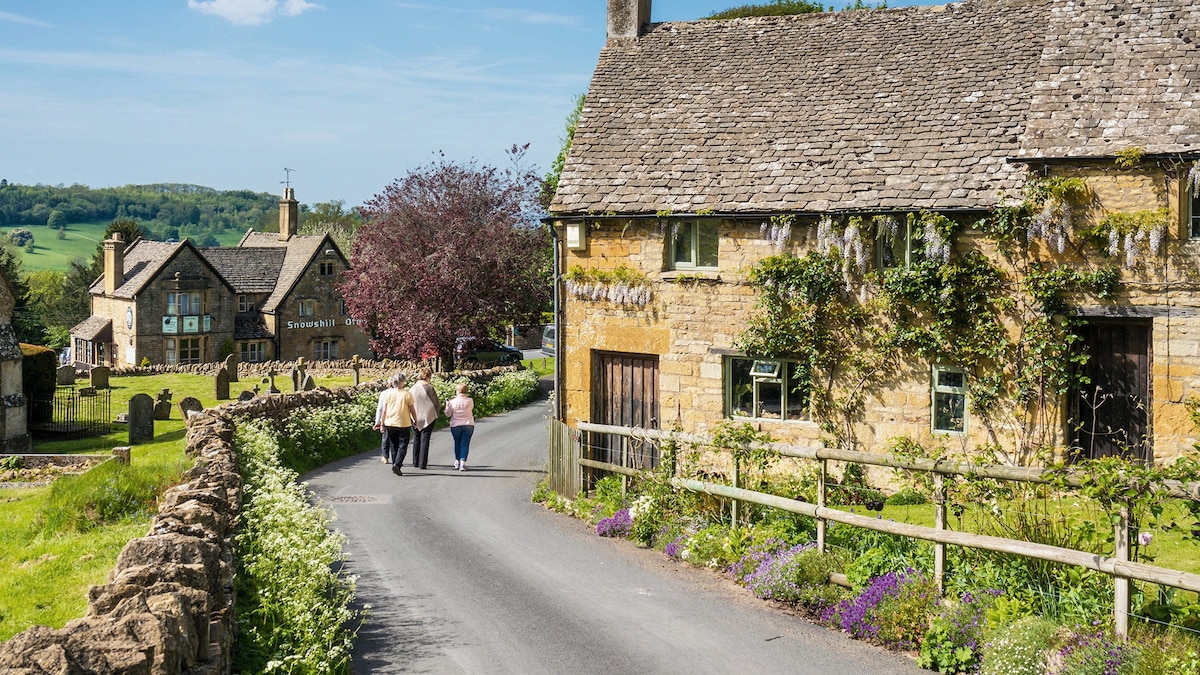Now Reading: 10 of the best hotels in the Cotswolds, England’s rural getaway
-
01
10 of the best hotels in the Cotswolds, England’s rural getaway
10 of the best hotels in the Cotswolds, England’s rural getaway

This article was produced by National Geographic Traveller (UK).
The Cotswolds fulfils every picture of rural England you might care to conjure. Pretty villages of ancient stone houses curl around country lanes, with low hills rolling between. Handsome market towns brim with antique shops and coaching inns. Sweeping over six counties in the south west, the region was made rich in the Middle Ages by the wool trade, and retains an air of unruffled, comfortable respectability. The Cotswolds’ quality produce has long been brought to life on menus in hotel restaurants and pubs with rooms, but openings and refurbishments over the past decade have brought a dash of retro cool and playful whimsy to the accommodation scene, too.


The countryside retreat The Pig in the Cotswolds blends cosy elegance with fresh, locally sourced dining.
Photograph by Jake Eastham
1. The Pig in the Cotswolds
Best for: local produce
The smell of log fires greets you as you enter The Pig in the Cotswolds, the 10th addition to the hotel group’s litter, which opened near Cirencester in Gloucestershire in late 2024. The 17th-century manor house — all honey-coloured stone and mullion windows — radiates a sense of homely comfort, from the warmth of the welcome to the simple elegance of bedrooms decorated in florals. That floral theme is brought to life in the arts and crafts-style garden, a legacy of one-time owner and horticulturalist Rosemary Verey. Star of the show is the restaurant’s 25 Mile Menu, with all ingredients sourced within a 25-mile radius of the hotel. Fresh herbs and beetroots from the kitchen garden and Cotswold lamb might appear on a changing menu of imaginative dishes served in the rustic dining room. Rooms: From £250.

Breakfast at The Rectory hotel is served in an airy winter garden with views of the grounds.
Photograph by Ed Schofield
2. The Rectory
Best for: homely elegance
Built in the 18th century, with enough bedrooms to accommodate the incumbent’s 14 children, The Rectory in the small Wiltshire village of Crudwell found a different calling when it became a boutique hotel in 2017. Many original features remain: framed antique maps and period furniture now complement the stone fireplaces, wide wooden floorboards and flagstone floors. The ambience is relaxed, with guests playing Monopoly by the fire in one of the lounges or drinking martinis on a squishy velvet sofa in the bar. Meals — taken in the wood-panelled dining room or adjoining glasshouse — are a highlight, and dishes might include pheasant tortellini or hake with brown shrimp, parsley and anchovy sauce. Walk it off with a stroll round the walled garden before dozing in one of 18 bedrooms, each a little cocoon of calm and some featuring quirks such as in-room roll-top baths. Rooms: From £170, B&B.
3. The Bull, Charlbury
Best for: ramblers
All timbered ceilings and roaring fireplaces, this historic pub has stood in the village of Charlbury, Oxfordshire, since the 1500s. If you’ve been exploring the surrounding countryside, you’ll likely be drawn inside by the prospect of a few small plates in the downstairs restaurant, whose chef works closely with local farmers to produce dishes at one with the seasons. Up a narrow spiral staircase, the best of The Bull’s 10 rooms look out onto honeyed stone cottages stitched into sage hills. Each bedroom has been designed with the weary rambler in mind, with vintage felt couches and, in the largest rooms, freestanding baths in which to soak weary limbs. You’ll even find a pair of hazel walking sticks by the door — an invitation to get lost, at least for a little while. Rooms: From £150.

Thyme’s English Rose room is a quintessential country dream in pink.
Photograph by Rachael Smith, Thyme
4. Thyme
Best for: connecting with nature
The natural world runs like a thread through Thyme in Gloucestershire, from the botanical prints and floral wallpaper designed by founder Caryn Hibbert to a menu that changes depending on what’s ready to be plucked from the kitchen gardens. The spa, too, makes use of botanicals drawn from Thyme’s water meadows, with unique treatments focused on scents and breathwork. Once you’ve explored the grounds, keeping an eye out for the myriad bird species drawn to its wild spaces, the hotel is an elementally calm place to return to. Natural materials and original features shine in the restored farm buildings that house the guest rooms, bar, boutique and gallery. The enormous Ox Barn restaurant, with vaulted ceiling, is an impressive setting in which to enjoy some of that homegrown produce, in dishes such as duck with prunes, apple and radicchio. Rooms: From £400, B&B.
5. Cowley Manor Experimental
Best for: distinctive design
Lewis Carroll got the idea for Alice in Wonderland while strolling the grounds of this 17th-century pile near Cheltenham, Gloucestershire, and guests today might also feel they’ve fallen down the rabbit hole. The hotel embraces bold colours and modern art, its Italianate bones dotted with playful chequerboard rugs and glazed lava stone. Thirty-six distinct, spacious bedrooms range from a three-floor ‘treehouse’ to a suite with a four-poster bed and private terrace. Owned by the same group as Paris’s Experimental Cocktail Club, the bar offers a wildcard-packed drinks list soundtracked by live DJ sets, while inventive meals are served in a magnificent, wood-panelled dining room. When you’re done with decadent loafing, head to the spa’s modernist swimming pool, where floor-to-ceiling windows offer glimpses of Churn Valley woodland. Rooms: From £302, B&B.

Cowley Manor’s interiors embrace modern art, its Italianate bones and chequerboard decor reminiscent of Alice in Wonderland.
Photograph by Mr Tripper
6. The Plough Inn
Best for: local life
Think of a quintessential country pub and you’ll picture something like this 17th-century inn in Kelmscott, Oxfordshire, with its flagstones, exposed beams and decorative cartwheels. The bar’s a hangout for locals, who pop in for hand-pulled beer by the log burner, and the restaurant offers a gastro take on the classics, from prawn cocktail to game pie. Up a creaking staircase are eight simple rooms featuring prints by 19th-century textile designer William Morris, who had a home in the village, now open as a museum. Rooms: From £95, B&B.
7. Artist Residence
Best for: modern art
Take a 16th-century farmhouse, add elements of a contemporary gallery and you get this place in the Oxfordshire village of South Leigh. William Morris wallpaper and mismatched furnishings in its pub provide a backdrop to pop-art prints and neon signs, while the restaurant serves dishes such as braised beef with bone marrow mash to diners on burnt-orange banquettes. Most of the nine rooms are in the outbuildings; among them is the Stable Room, with original wood beams and a freestanding bath. Rooms: From £150.
8. The Kingham Plough
Best for: gastropub culture
Ease your vehicle through a stone carriage archway before walking through a weathered door into a room with a blazing hearth: arriving at this converted coaching inn probably feels much as it did 400 years ago. Welcoming staff serve high-end pub food championing local produce, enjoyed in the cosy dining room or by the fire. All six bedrooms offer a muted palette enhanced by florals and stripes. New for 2025 is self-catering property Little Barn, sleeping four. Rooms: From £195, or Little Barn from £445, both B&B.

Foxhill Manor is a master at informal luxury, welcoming guests to make themselves at home.
Photograph by Foxhill Manor
9. Foxhill Manor
Best for: laid-back luxury
If you’ve wondered what it might be like to live in a very big house in the country, at least for a bit, book in at Foxhill Manor. On a 500-acre estate overlooking Worcestershire’s Broadway village, the vibe at the arts and crafts villa is ‘make yourself at home’. There are no set meal times or formal dining room, so guests wander into the kitchen to discuss preferences with the chef and eat when and where they fancy — perhaps in an armchair by the fire or a window seat overlooking the grounds. Staff manage the rare feat of attending to your every whim with friendly informality, whether topping up the free-flowing Champagne, delivering afternoon tea to the private cinema or firing up the hot tub in time for a sunrise dip. With only eight rooms — all unique though sharing a timelessly elegant style and generous proportions — you’re soon making friends with other guests, too. As an extra treat, book the Full Fox experience, inclusive of all food and drinks (bar fine wines) and access to the spa at sister hotel Dormy House. Rooms: From £595, all inclusive.

A medium room at the Double Red Duke offers ultimate relaxation with a freestanding bedside bathtub.
Photograph by Chris Terry
10. Double Red Duke
Best for: a sense of fun
Named for the 16th-century duke who lived here and gifted Double Red Corn to villagers, the first thing you notice at this Clanfield hotel is its parasols: candy-striped against honeyed stone. Inside lies a warren of low-ceilinged snugs, where log fires and sage armchairs pair well with whisky. The heart of the hotel is an open kitchen, in which chefs fire Galician Blond beef ribs worthy of a T-rex for counterside diners. Alternatively, try the new Mason’s Arms over the road, a coaching inn that’s part of the hotel and serves seasonal dishes like sole with seashore vegetables. When it’s time to sleep off any overindulgence, 19 rooms await, decorated with vintage furniture and patterned wallpaper. Buffet breakfasts are in the sunny Garden Room, a greenery-filled space that also functions as the bar. Rooms: From £200, B&B.
Published in the April 2025 issue of National Geographic Traveller (UK).
To subscribe to National Geographic Traveller (UK) magazine click here. (Available in select countries only).

























